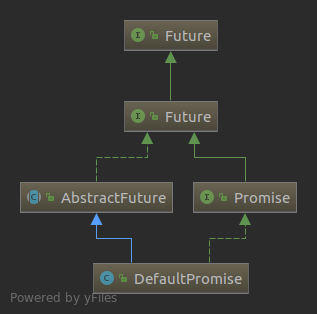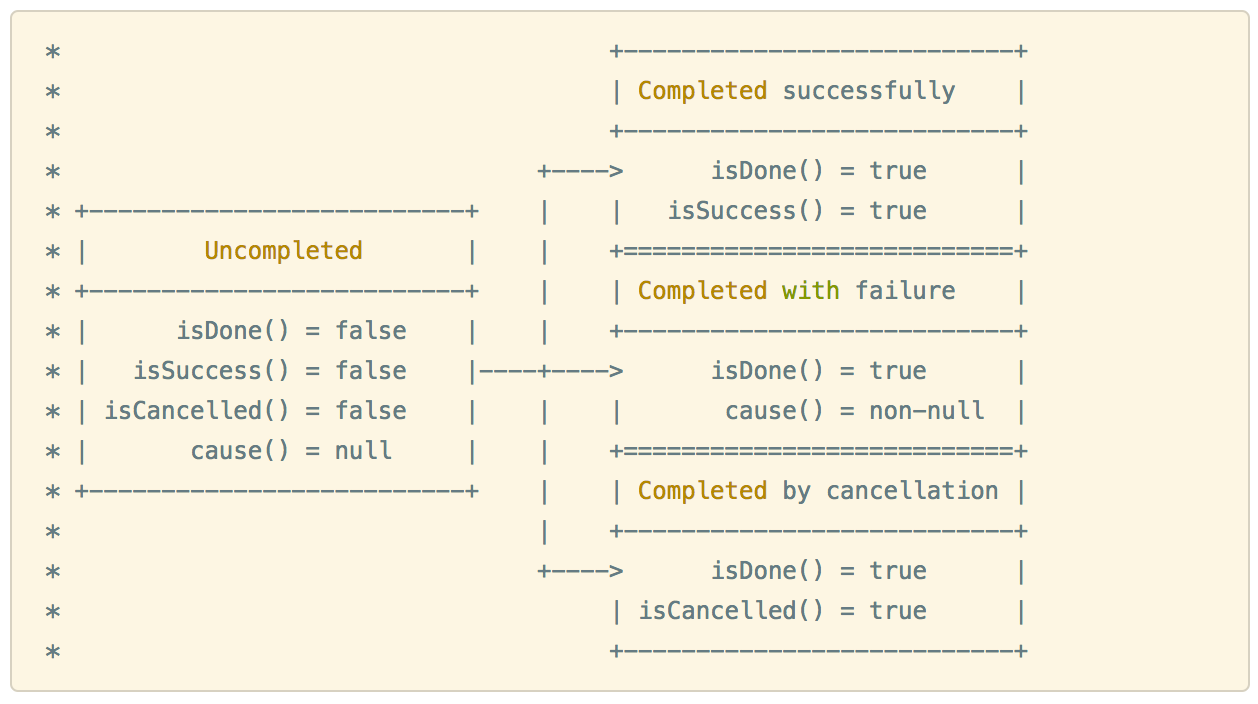从Java 1.5开始,JDK就提供了Callable和Future,通过它们可以在任务异步执行完毕之后获取任务的执行结果。
Netty扩展了JDK中的Future机制,下面我们来看一张Netty中Future和Promise类关系图:

最上面的Future是JDK提供的Future接口,我们看一下里面有哪些方法:
1 | package java.util.concurrent; |
并发编程中,我们通常会用到一组非阻塞的模型:Promise,Future 和 Callback。其中的 Future 表示一个可能还没有实际完成的异步任务的结果,针对这个结果可以添加 Callback 以便在任务执行成功或失败后做出对应的操作,而Promise交由任务执行者,任务执行者通过 Promise 可以标记任务完成或者失败。 这一套模型是很多异步非阻塞架构的基础。 因为netty中也有类似调用者和执行部件以异步的方式交互通信结果的需求(要知道eventloop本质上是一个ScheduledExecutorService,ExecutorService是一种“提交-执行”模型实现,也存在线程间异步方式通信和线程安全问题),所以netty自己实现了一套。
Netty中所有的IO操作都是异步的(比如write(Object),因为Netty中一个EventLoop要服务于多个SocketChannel,所以通过socketChannel.xx只是提交一个任务,何时返回结果是不确定的),而不像传统的BIO那样阻塞等待操作完成,来获取执行结果。
事实上,Netty Future的建议操作模式就是赤裸裸的通知,执行部件改变状态时,会执行注册在future上的Listener(变相的观察者模式)。
scala在语言层面提供对Promise,Future和Callback模型的支持,https://bitbucket.org/qiyi/commons-future.git作者自定义实现了该模型,去除了Netty的Future模型对EventLoop的依赖。
Netty中的Future
下面的Netty Future继承jdk提供的Future接口,添加了一些自己的方法:
1 | /** |

a future is a read-only placeholder view of a variable, while a promise is a writable。Promise是可写的Future,提供写操作相关的接口,用于设置IO操作的结果。Future,Promise,callback抽象出一套调用者与执行部件间的通信模型(不只是netty中),Future像是给调用者用的(拿结果),Promise像是给执行部件用的(设置结果),它们简化了调用者和执行部件对其的调用(调用者get,执行部件set),但本身要封装很多事。比如Future必须是一个线程安全的类(大部分时候,调用者和执行部件身处两个线程),比如执行callback(或者listener)。
Netty Promise执行Listener
Netty中的Promise通常由EventLoop创建,也就是Promise通常会绑定executor。为何呢?因为Netty保证Listener的执行,一定是在channel对应的EventLoop中(????)。